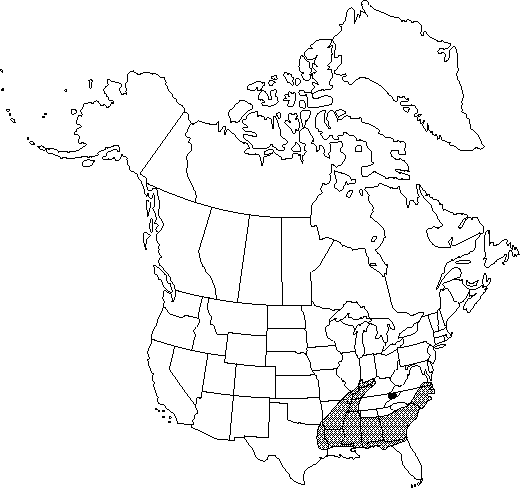Quercus pagoda
Alsogr. Amer., 23. 1838.
Trees, deciduous, to 40 m. Bark nearly black with narrow and noticeably flaky ridges, often resembling that of wild black cherry, inner bark orange. Twigs yellowish-brown, 2-3.5 mm diam., pubescent. Terminal buds light reddish-brown, ovoid, 4-9 mm, strongly 5-angled in cross-section, puberulent throughout. Leaves: petiole 20-50 mm, glabrate or pubescent. Leaf-blade ovate to elliptic or obovate, 90-300 × 60-160 mm, base cuneate to rounded or truncate, margins with 5-11 lobes and 10-25 awns, lobes oblong, rarely falcate, terminal lobe rarely exceeding lateral lobes in length, apex acute; surfaces abaxially pale, tomentose, adaxially glossy, glabrous, secondary-veins raised on both surfaces. Acorns biennial; cup saucer-shaped to cupshaped, 3-7 mm high × 10-18 mm wide, covering 1/3-1/2 nut, outer surface puberulent, inner surface pubescent, scale tips tightly appressed, acute; nut subglobose, 9-15 × 8-16 mm, often striate, puberulent, scar diam. 5-9 mm.
Phenology: Flowering spring.
Habitat: Poorly drained bottoms and mesic slopes
Elevation: 0-300 m
Distribution

Ala., Ark., Fla., Ga., Ill., Ind., Ky., La., Miss., Mo., N.C., Okla., S.C., Tenn., Tex., Va.
Discussion
Quercus pagoda is often treated as a variety of Q. falcata; it is quite distinctive, however, both morphologically and ecologically (S. A. Ware 1967; R. J. Jensen 1989).
This species reportedly hybridizes with Q. falcata and Q. phellos (D. M. Hunt 1989).
Selected References
None.
